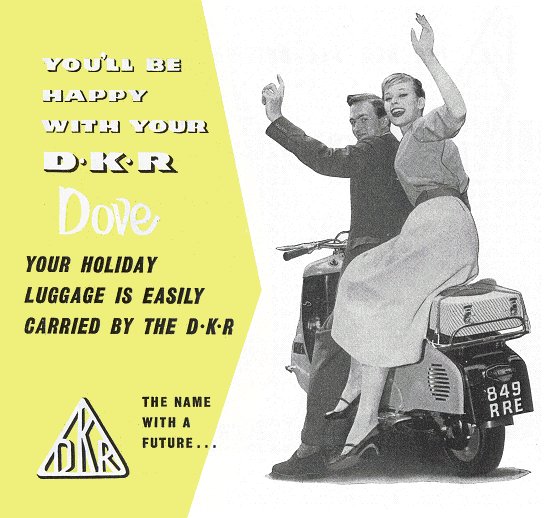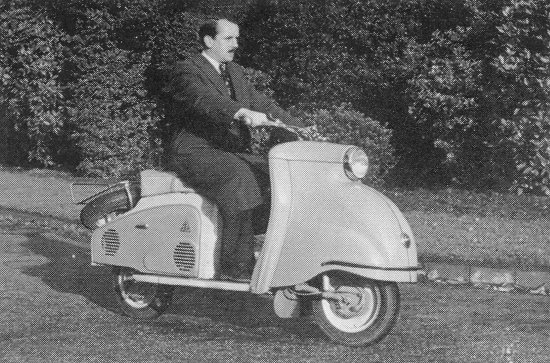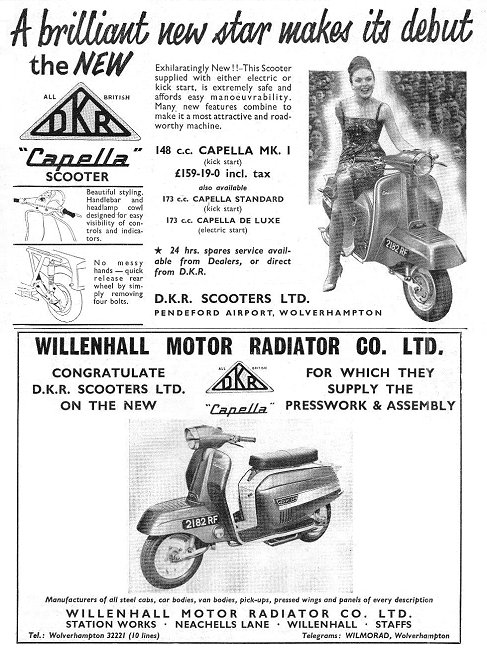D.K.R. Scooters
| DKR was founded in 1957 by three
industrialists; Barry Day, managing director of the Willenhall Motor
Radiator Company, Noah Robinson, a director of the Willenhall Motor Radiator
Company, and Cyril Kieft, who built racing cars, and imported motor
scooters. The company was run from premises at Pendeford
Airport. Cyril Kieft designed the machines, which were constructed at the
Willenhall Motor Radiator Company's factory in Neachells Lane.
DKR’s first machine, the 'Dove', appeared in
July 1957. It was powered by a Villiers 147c.c. fan-cooled engine with a
"square" bore of 57mm x 58mm, and a compression ratio of 7.5:1. It developed
6.3b.h.p. at 5,000r.p.m.
The Dove was fitted with a three-speed gearbox,
and a kick
starter, and was painted in 2 tone blue. It sold for
£162.15s.0d.
Sales were very good and more
models soon followed.
|
 |
|

An advert from Motor Cycling
magazine, 25th July, 1957. |
 |
The front cover of the sales
literature. Courtesy of Brian
Shaw. |
| The technical data page in the
sales literature. Courtesy of
Brian Shaw. |
 |
 |
Another page from the sales
literature. Courtesy of Brian
Shaw. |
| The specification of the 147 c.c.
Villiers engine. Courtesy of
Brian Shaw. |
 |
|

An advert from 1957. |
The 'Pegasus', 'Defiant' and 'Manx' were introduced in 1958.
The 'Pegasus' and 'Defiant' were identical apart from the engine.
The 'Defiant' was powered by a 197c.c. blower cooled, single-cylinder, two-stroke Villiers engine.
It had a 12 Volt Siba 'Dynastart'
electric starter, which ensured first time starting. It was also fitted with a
four-speed gearbox, a Villiers carburettor, and could could
achieve 60m.p.h.
The petrol
consumption was 90m.p.g. at 30m.p.h. and the selling price was £189.15s.5d.
The cheaper 'Pegasus' was fitted with the newly introduced 148c.c. Villiers 31C/3SF engine. It sold for £177.11s.11d.
|

The 'Defiant' from the 1958 catalogue.
Courtesy of the late Jim Boulton.

The 'Defiant' with the side panel removed, to
expose the compact engine. Courtesy of the late Jim Boulton. |
| The 'Defiant' and 'Pegasus' had a Reynolds all-welded main frame, and
sub-frame, carrying a 10 piece panel assembly. 14s.w.g. mild steel plates
were added to the tubular frame to give further rigidity.
Girling type MDL lightweight suspension units were fitted, and the side panels were easily
removed to provide good access to the interior.
Both wheels had 3.5" x 10" tyres. The front wheel was of the split disc
type, with a 5" diameter brake. The rear wheel was fitted with a 6" diameter
brake.
The front forks were designed by DKR and fitted with Girling units,
and hydraulic damping.
The welded steel petrol tank had a capacity of 1.75
gallons, and each machine was supplied with a tool kit, spare wheel and
chrome luggage carrier.
|

An advert from 1958. |
|

The 'Defiant' handlebars and neat control panel.
Courtesy of the late Jim Boulton. |
The control panel on the 'Pegasus' and 'Defiant' had a
large ignition switch, a starter button, warning light, 3 position light
switch, and an 80m.p.h. Smith's speedometer in the centre.
The handlebars,
headlamp rim and exhaust tail were chrome plated. A 2 tone colour finish was
available for all models in the following combinations:
red, green,
pink, black, blue or maroon front and side panels with an ivory centre body,
or black and green. |
| Below the seat were
the two 6 Volt high capacity Silver Exide batteries which were wired in
series to give 12 Volts.
Photo courtesy of the late Jim Boulton.
|
 |
 |
The side panel could be easily removed to expose the 197c.c.
engine. Photo courtesy of the late Jim Boulton. |
| Twin dampers were fitted front and rear to ensure a
comfortable and stable ride. Photo courtesy of
the late Jim Boulton. |
 |

The side view of a 'Defiant'. Courtesy of
Eric Loffman.

Another view of a 'Defiant'. Courtesy of
Eric Loffman.
 |
Another view of the 'Defiant' and 'Pegasus'
handlebars and control panel. Courtesy of Eric Loffman |
|
A detailed drawing of the
'Defiant'.
Courtesy of Eric Loffman.
|
 |
 |
The highly efficient DKR silencer with
detachable end plate for easy cleaning.
Courtesy of Brian Shaw. |
| The 'Defiant' was powered by a 197c.c. Villiers
Mark 9E/4SF engine.
The engine had a 59m.m. bore and a 72m.m. stroke, and had a
compression ratio of 7.5:1. It produced 8.4b.h.p. at
4,000r.p.m., and was fitted
with a Villiers S25 carburettor. |

The Villiers Mark 9E/4SF engine. Courtesy of
Eric Loffman. |
 |
Another view of a 'Defiant' with the side
panel and seat removed, showing the ease of access to the engine.
Courtesy of Eric Loffman. |
| Eric Loffman riding his 1959 'Defiant'
at the Festival of Black Country Vehicles, at the Black Country
Living Museum, in July 2009. |
 |
 |
Another view of Eric Loffman's fine 'Defiant'. At the 2003 Black Country Vehicle Rally at the
Black Country Living Museum. |
A day out on a 'Defiant'.
Courtesy of the late Jim Boulton. |
 |
 |
The 'Defiant' offered
cheap daily travel.
Courtesy of the late Jim Boulton. |
| The 'Defiant' luggage carrier was
ideal for day-to-day shopping.
Courtesy of the late Jim Boulton.
|
 |
 |
The 'Defiant' that is in the
collection at the Black Country Living
Museum, Dudley. |
| Another view of the 'Defiant'
at the Black Country Living
Museum, Dudley. |
 |
 |
'Pegasus' scooters being
evaluated for police duties, in 1959.
Left to right:
WPC Blossom Timmins, Inspector P.D. Peterson, Jimmy Goodhall (DKR
Sales Manager), WPS Monica Taylor, Chief Constable Norman
Goodchild O.B.E.
Courtesy of the late Jim Boulton. |
| A 'Defiant'.
Courtesy of Brian Shaw. |
 |
 |
The top of the range model, the ‘Manx’, was powered by a
249c.c. Villiers twin-cylinder, two-stroke engine, had a top speed of
70m.p.h., and sold for £214.9s.7d. It did very well in competitions.
Photo courtesy of Brian Shaw.
|

Courtesy of Brian Shaw.
| 1960 saw the launch of the 'Capella', powered
by a 148c.c., single-cylinder, two-stroke Villiers engine, with a top speed
of 53m.p.h. and a selling price of £144.9s.6d.
It was fitted with a 3-speed
gearbox, Villiers carburettor, and had a kick starter.
There was also the
' Capella Standard', fitted with a 173c.c. Villiers engine, a four-speed
gearbox, and sold for £152.13s.6d.
There were also two de luxe versions with an electric
starter. The 173c.c. model was priced at £166.10s.10d. and the 200c.c. model was
priced at £173.13s.10d.
Sadly production ceased in
1966, due to falling sales and increased foreign competition.
|

The front cover from the 1960 catalogue.
Courtesy of the late Jim Boulton. |
 |
An advert from the Motor Cycle
magazine, 6th October, 1960. |
| An advert from Motor Cycling
and Scooter Weekly, 6th October, 1960. |
 |

The 'Capella' specification and price list.
Courtesy of the late Jim Boulton.
 |
'Capella' accessories and price list.
Courtesy of the late Jim Boulton. |
|
The centre picture in the 1960 catalogue.
Courtesy of the late Jim Boulton.
|
 |
 |
The 'Capella' handlebars and headlamp
cowl, designed for easy visibility of the controls, with limited
beam adjustment. Courtesy of the
late Jim Boulton. |
| When lifted, the seat exposed the
filler cap, fuel tap, and sparking plug.
Courtesy of the late Jim Boulton. |
 |
 |
The rear wheel could quickly be
removed by releasing the four wheel nuts.
Courtesy of the late Jim Boulton. |
| The front suspension consisted of
a pivoted fork with twin hydraulic dampers.
Courtesy of the late Jim Boulton. |
 |

Another picture from the 1960
catalogue.
Courtesy of the late Jim Boulton. |

|